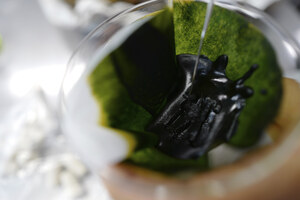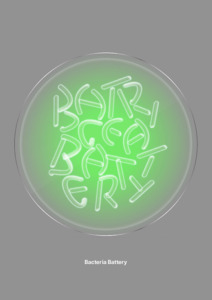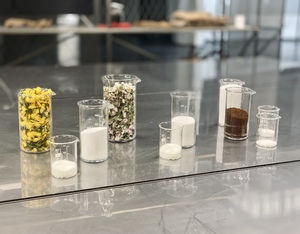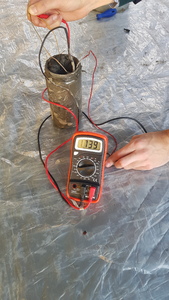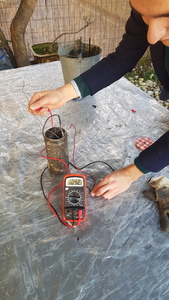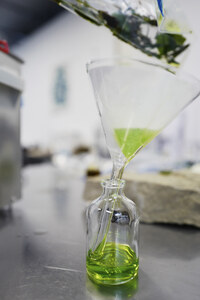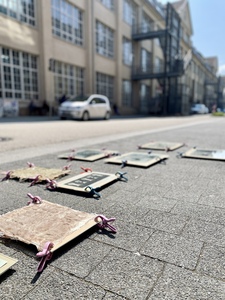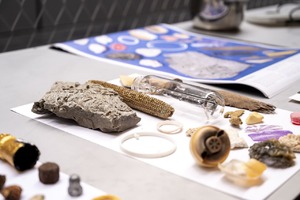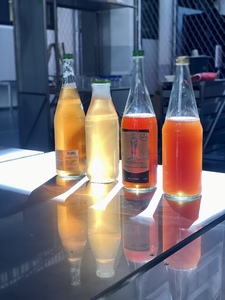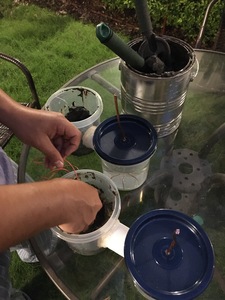"Staatliche Hochschule für Gestaltung (HfG) Karlsruhe"
| Begriff | Staatliche Hochschule für Gestaltung (HfG) Karlsruhe |
| Metakey | Ort: Institution (creative_work:location_institution) |
| Typ | Keyword |
| Vokabular | Werk |
636 Inhalte
- Seite 1 von 53
Kritische Zone riechen und sehen
- Titel
- Kritische Zone riechen und sehen
- Titel (en)
- Seeing and smelling the Critical Zone
- Beschreibung (de)
- Fotografien die während des Workshops „Kritische Zone riechen und sehen" entstandenen sind.
- Beschreibung (en)
- Photographs taken during the workshop "Smell and see critical zone".
- Typ des Projekts/Werks
- Schlagworte
- Datierung
- Sommersemester 2021
- Mitwirkende
- Ort: Institution
- Ort
- Bio Design Lab
- Stadt
- Land
- Beteiligte Institution(en)
- Internetlinks
- Titel
- Kritische Zone riechen und sehen
- Urheberrechtshinweis
- Bio Design Lab, Michael Rybakov
- Rechtsschutz/Lizenz
- Medienersteller/in
- Projektleiter/in
- Semester
- Importiert am
- 30.10.2023
- Übergeordnete Sets
- 1
Bacteria Battery
- Titel
- Bacteria Battery
- Titel (en)
- Bacteria Battery
- Beschreibung (de)
- Dokumentation des Workshops „Bacteria Battery“ geleitet von Dr. Rasa Smite und dem Bio Design Lab.
- Beschreibung (en)
- Documentation of the "Bacteria Battery" workshop led by Dr. Rasa Smite and the Bio Design Lab.
- Typ des Projekts/Werks
- Schlagworte
- Datierung
- 29.01.2021
- Mitwirkende
- Material
- Ort: Institution
- Ort
- Bio Design Lab
- Stadt
- Land
- Internetlinks
- Titel
- Bacteria Battery
- Urheberrechtshinweis
- Bio Design Lab
- Rechtsschutz/Lizenz
- Medienersteller/in
- Projektleiter/in
- Semester
- Importiert am
- 25.10.2023
- Übergeordnete Sets
- 1
Photosymbiosen – On Co-Developing with Plant Accomplices
- Titel
- Photosymbiosen – On Co-Developing with Plant Accomplices
- Titel (en)
- Photosymbiosen – On Co-Developing with Plant Accomplices
- Untertitel
- Sustainable Photography
- Beschreibung (de)
- Dokumentation der Recherche für das Projekt „Photosymbiosen – On Co-Developing with Plant Accomplices“.
- Beschreibung (en)
- Documentation of research for the project "Photosymbioses - On Co-Developing with Plant Accomplices".
- Typ des Projekts/Werks
- Schlagworte
- Datierung
- Sommersemester 2021
- Mitwirkende
- Material
- Ort: Institution
- Stadt
- Land
- Internetlinks
- Titel
- Photosymbiosen – On Co-Developing with Plant Accomplices
- Urheberrechtshinweis
- Bio Design Lab
- Rechtsschutz/Lizenz
- Freigabe Nutzung HfG
- Semester
- Importiert am
- 30.10.2023
- Übergeordnete Sets
- 1
Bacteria Battery
- Titel
- Bacteria Battery
- Titel (en)
- Bacteria Battery
- Beschreibung (de)
- Fotografien des Entstehungsprozesses und der Endergebnisse von dem Workshop „Bacteria Battery“ geleitet von Dr. Rasa Smite und dem Bio Design Lab.
- Beschreibung (en)
- Photographs of the process and final results from the "Bacteria Battery" workshop led by Dr. Rasa Smite, Raitis Smits and the Bio Design Lab.
- Typ des Projekts/Werks
- Schlagworte
- Datierung
- 29.01.2021
- Mitwirkende
- Material
- Ort: Institution
- Ort
- Bio Design Lab
- Stadt
- Land
- Internetlinks
- Titel
- Bacteria Battery
- Urheberrechtshinweis
- Bio Design Lab
- Rechtsschutz/Lizenz
- Medienersteller/in
- Projektleiter/in
- Semester
- Importiert am
- 25.10.2023
- Übergeordnete Sets
- 1
Bacteria Battery
- Titel
- Bacteria Battery
- Titel (en)
- Bacteria Battery
- Beschreibung (de)
- Fotografien des Entstehungsprozesses und der Endergebnisse von dem Workshop „Bacteria Battery“ geleitet von Dr. Rasa Smite und dem Bio Design Lab.
- Beschreibung (en)
- Photographs of the process and final results from the "Bacteria Battery" workshop led by Dr. Rasa Smite, Raitis Smits and the Bio Design Lab.
- Typ des Projekts/Werks
- Schlagworte
- Datierung
- 29.01.2021
- Mitwirkende
- Material
- Ort: Institution
- Ort
- Bio Design Lab
- Stadt
- Land
- Internetlinks
- Titel
- Bacteria Battery
- Urheberrechtshinweis
- Bio Design Lab
- Rechtsschutz/Lizenz
- Medienersteller/in
- Projektleiter/in
- Semester
- Importiert am
- 25.10.2023
- Übergeordnete Sets
- 1
Kritische Zone riechen und sehen
- Titel
- Kritische Zone riechen und sehen
- Titel (en)
- Seeing and smelling the Critical Zone
- Beschreibung (de)
- Fotografien die während des Workshops „Kritische Zone riechen und sehen" entstandenen sind.
- Beschreibung (en)
- Photographs taken during the workshop "Smell and see critical zone".
- Typ des Projekts/Werks
- Schlagworte
- Datierung
- Sommersemester 2021
- Mitwirkende
- Ort: Institution
- Ort
- Bio Design Lab
- Stadt
- Land
- Beteiligte Institution(en)
- Internetlinks
- Titel
- Kritische Zone riechen und sehen
- Urheberrechtshinweis
- Bio Design Lab, Michael Rybakov
- Rechtsschutz/Lizenz
- Medienersteller/in
- Projektleiter/in
- Semester
- Importiert am
- 30.10.2023
- Übergeordnete Sets
- 1
Photosymbiosen – On Co-Developing with Plant Accomplices
- Titel
- Photosymbiosen – On Co-Developing with Plant Accomplices
- Titel (en)
- Photosymbiosen – On Co-Developing with Plant Accomplices
- Untertitel
- Sustainable Photography
- Beschreibung (de)
- Dokumentation der Recherche für das Projekt „Photosymbiosen – On Co-Developing with Plant Accomplices“.
- Beschreibung (en)
- Documentation of research for the project "Photosymbioses - On Co-Developing with Plant Accomplices".
- Typ des Projekts/Werks
- Schlagworte
- Datierung
- Sommersemester 2021
- Mitwirkende
- Material
- Ort: Institution
- Stadt
- Land
- Internetlinks
- Titel
- Photosymbiosen – On Co-Developing with Plant Accomplices
- Urheberrechtshinweis
- Bio Design Lab
- Rechtsschutz/Lizenz
- Freigabe Nutzung HfG
- Semester
- Importiert am
- 30.10.2023
- Übergeordnete Sets
- 1
Bacteria Battery
- Titel
- Bacteria Battery
- Titel (en)
- Bacteria Battery
- Beschreibung (de)
- Fotografien des Entstehungsprozesses und der Endergebnisse von dem Workshop „Bacteria Battery“ geleitet von Dr. Rasa Smite und dem Bio Design Lab.
- Beschreibung (en)
- Photographs of the process and final results from the "Bacteria Battery" workshop led by Dr. Rasa Smite, Raitis Smits and the Bio Design Lab.
- Typ des Projekts/Werks
- Schlagworte
- Datierung
- 29.01.2021
- Mitwirkende
- Material
- Ort: Institution
- Ort
- Bio Design Lab
- Stadt
- Land
- Internetlinks
- Titel
- Bacteria Battery
- Urheberrechtshinweis
- Bio Design Lab
- Rechtsschutz/Lizenz
- Medienersteller/in
- Projektleiter/in
- Semester
- Importiert am
- 25.10.2023
- Übergeordnete Sets
- 1
Kritische Zone riechen und sehen
- Titel
- Kritische Zone riechen und sehen
- Titel (en)
- Seeing and smelling the Critical Zone
- Beschreibung (de)
- Fotografien die während des Workshops „Kritische Zone riechen und sehen" entstandenen sind.
- Beschreibung (en)
- Photographs taken during the workshop "Smell and see critical zone".
- Typ des Projekts/Werks
- Schlagworte
- Datierung
- Sommersemester 2021
- Mitwirkende
- Ort: Institution
- Ort
- Bio Design Lab
- Stadt
- Land
- Beteiligte Institution(en)
- Internetlinks
- Titel
- Kritische Zone riechen und sehen
- Urheberrechtshinweis
- Bio Design Lab, Michael Rybakov
- Rechtsschutz/Lizenz
- Medienersteller/in
- Projektleiter/in
- Semester
- Importiert am
- 30.10.2023
- Übergeordnete Sets
- 1
Kritische Zone riechen und sehen
- Titel
- Kritische Zone riechen und sehen
- Titel (en)
- Seeing and smelling the Critical Zone
- Beschreibung (de)
- Fotografien die während des Workshops „Kritische Zone riechen und sehen" entstandenen sind.
- Beschreibung (en)
- Photographs taken during the workshop "Smell and see critical zone".
- Typ des Projekts/Werks
- Schlagworte
- Datierung
- Sommersemester 2021
- Mitwirkende
- Ort: Institution
- Ort
- Bio Design Lab
- Stadt
- Land
- Beteiligte Institution(en)
- Internetlinks
- Titel
- Kritische Zone riechen und sehen
- Urheberrechtshinweis
- Bio Design Lab, Anthea Oestreicher
- Rechtsschutz/Lizenz
- Medienersteller/in
- Projektleiter/in
- Semester
- Importiert am
- 30.10.2023
- Übergeordnete Sets
- 1
Photosymbiosen – On Co-Developing with Plant Accomplices
- Titel
- Photosymbiosen – On Co-Developing with Plant Accomplices
- Titel (en)
- Photosymbiosen – On Co-Developing with Plant Accomplices
- Untertitel
- Sustainable Photography
- Beschreibung (de)
- Dokumentation der Recherche für das Projekt „Photosymbiosen – On Co-Developing with Plant Accomplices“.
- Beschreibung (en)
- Documentation of research for the project "Photosymbioses - On Co-Developing with Plant Accomplices".
- Typ des Projekts/Werks
- Schlagworte
- Datierung
- Sommersemester 2021
- Mitwirkende
- Material
- Ort: Institution
- Stadt
- Land
- Internetlinks
- Titel
- Photosymbiosen – On Co-Developing with Plant Accomplices
- Urheberrechtshinweis
- Bio Design Lab
- Rechtsschutz/Lizenz
- Freigabe Nutzung HfG
- Semester
- Importiert am
- 30.10.2023
- Übergeordnete Sets
- 1
Bacteria Battery
- Titel
- Bacteria Battery
- Titel (en)
- Bacteria Battery
- Beschreibung (de)
- Fotografien des Entstehungsprozesses und der Endergebnisse von dem Workshop „Bacteria Battery“ geleitet von Dr. Rasa Smite und dem Bio Design Lab.
- Beschreibung (en)
- Photographs of the process and final results from the "Bacteria Battery" workshop led by Dr. Rasa Smite, Raitis Smits and the Bio Design Lab.
- Typ des Projekts/Werks
- Schlagworte
- Datierung
- 29.01.2021
- Mitwirkende
- Material
- Ort: Institution
- Ort
- Bio Design Lab
- Stadt
- Land
- Internetlinks
- Titel
- Bacteria Battery
- Urheberrechtshinweis
- Bio Design Lab
- Rechtsschutz/Lizenz
- Medienersteller/in
- Projektleiter/in
- Semester
- Importiert am
- 25.10.2023
- Übergeordnete Sets
- 1
